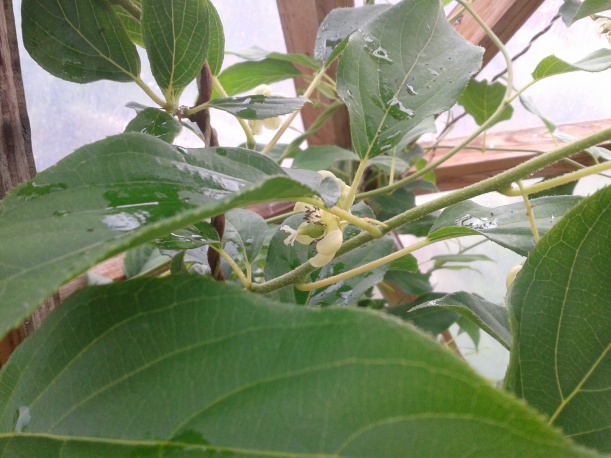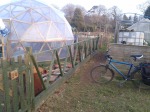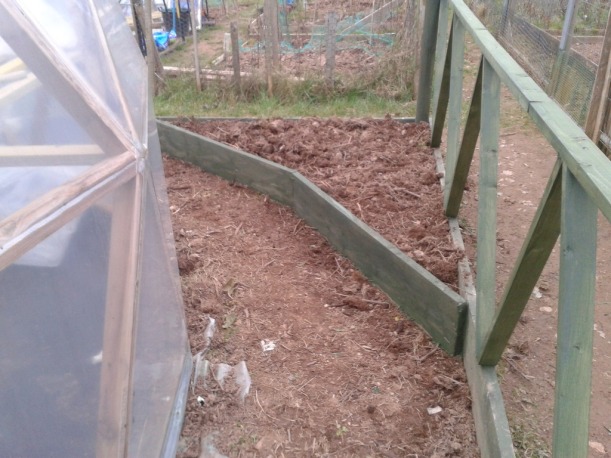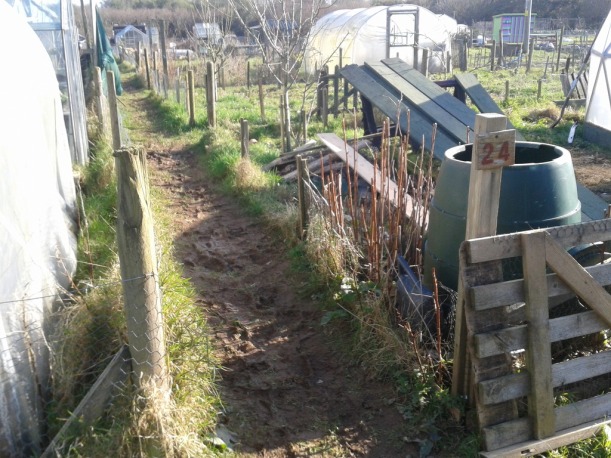I watched the weather on the met office website avidly from midweek hoping that Sunday would be fine with light winds. First the weather looked OK then the next day Malcolm called to ask if I really wanted to go ahead on Sunday as the weather looked really bad. On the day everything worked out fine. It was not too hot with a moderate breeze. We were good to go.
I went to work in the morning, made sure both batteries for the battery drill were charged, cut the door reveals from 12mm ply and cut some steel stakes to anchor the base to the ground then up to the site to hammer them in ready for the build in the afternoon. The ground is so hard on our allotment, the steel anchor pins burring over from the continuing assault from the lump hammer. I don’t think the dome is going to go anywhere in the wind.
 Ground Anchors holding the geodesic Dome greenhouse to the ground.
Ground Anchors holding the geodesic Dome greenhouse to the ground.
Right, the stage was now set to build the dome. The base was round, level and secure. All the panels were up on site and my battery drill was charged up. Just one more thing. Back home for a full Cornish breakfast.
Back on site for about 12.30 I decided to make a start on my own. I was expecting a couple of friends to turn up around one but I couldn’t wait to get started. The first layer of the dome is alternating half hexagon and full hexagon panels. I decided to fit all the half hex panels in place first as these were easy to handle on your own. I had a bit of a shock when I tried to fit the first half panel. It was nowhere near the right shape. I screwed the fist edge to the base but the remaining edge stuck outside the ring of the base by a good 100mm. What on earth had I done wrong? I had followed the plans. If this panel was wrong then all the panels would be wrong. I grasped the wayward edge and gently eased it towards it’s intended location and to my surprise and relief it swung into place with just enough tension to make the panel nice and stiff and able to resist any wind that might suddenly blow through. I quickly fitted the remaining half panels and all behaved in the same way. The build was on.

The first panels in place for the Geodesic Dome Greenhouse
The next step is to fit the full hex panels. This should be a simple job of just clamping the the full panels to the half panels and screwing them together but nothing could be that simple. In order to give myself some wiggle room I had fitted the half panels slightly outwards from the centre of the base. The great thing about building a dome is it is built on a circle. If the panels are too tight to fit together you can move them outwards away from the centre of the circle to give yourself more space. If the panels are too loose just move them in a little. I need to learn to trust the plans and my own work and put the panels exactly where they needed to go. I repositioned the half panels so their edges lined up perfectly with the joints in the base and the full hex panels just fell into place.

First layer of full hexagon panels in place
We hold the panels tightly together with welding clamps. There is more information about all the tools you will need to build a dome like this on our Geodesic Dome page. The welding clamps are like having a spare pair of super strong hands. They allow you to securely hold a panel on place and quickly adjust the fit. They also help pull the panels tight whist screwing them together.
 This is what your joints should look like.
This is what your joints should look like.
At this point reinforcements turned up and then we progressed really quickly. It would have taken me much longer to build the dome on my own.
Malcolm and Jules got on with taping the seams on all the panels ready for them to go into the dome and Max and I carried on fitting panels.

Now starting to take shape with the help of friends
The next layer of the dome is a row of pentagon panels and this just follows the pattern of clamping, adjusting and screwing in place. I was really surprised at how quickly the build was going.

First row of pentagon panels in place. You can see the welding clamps to the left of the door.
Next was a row of Hex panels

Just one more hex panel and the the final pentagon and we are done

Just the last pentagon to go in.
And by 3 O’Clock we were pretty much done with the main structure of the dome so it was down to the pub for a celebratory pint to thank my helpers.

And that is it for the main structure.
Back from the pub and on my own again I took my time and fitted the custom panels around the door and fitted the plywood reveals. Next job, the door and door frame.
 Door reveals
Door reveals

And here is the finished Geodesic Dome Greenhouse.
I would like to thank Jules for putting up with my Dome obsession and helping me to achieve my goal. And of course I need to thank Max and Malcolm for their help with the building of the dome. it would have been a lot harder without you guys.
There is nothing I would change about the design of the dome as I think it is perfect but I have learned a lot during the build and I would do things a little differently on the next on.
I spent a lot of time getting the base round and level but this was unnecessary. On the next build I will attach the base boards to the the first set of panels at the workshop before they are transported to the building site. This will speed things up as the base will just go in as the first row of panels go in. This will save a lot of time. Another area that I think could be prefabricated at the workshop is the door, door frame, reveals and custom panels to each side of the door. I would then just treat this as a standard Hexagon panel that would be built into the dome as part of the first row.
Another area I am looking at is making the last row of hexagons and the final pentagon in one piece on the ground at the build site and then fitting this whole assembly in one go. This means that we can seal all the joints with polytunnel repair tape without having to climb onto the dome. this will reduce the risk of damaging the plastic with ladders etc but also ensure that the taping is to a high standard. I will have to experiment with this last one as the pane may be too heavy or unwieldy to fit in one piece.
If you would like a dome like this in your garden or allotment we are now producing them as a kit.
Please call Paul on 07796890337 to discuss options.
Thanks
Paul




















 Ground Anchors holding the geodesic Dome greenhouse to the ground.
Ground Anchors holding the geodesic Dome greenhouse to the ground.

 This is what your joints should look like.
This is what your joints should look like.




 Door reveals
Door reveals



